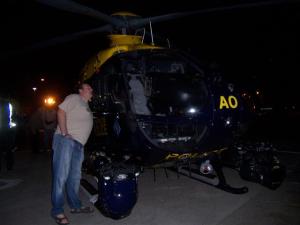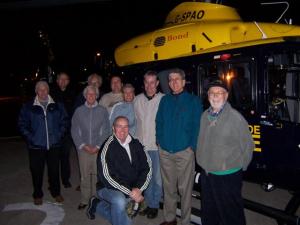On the evening of Wednesday 3rd November, the Club was treated to a tour of the Strathclyde Police Air Support Unit helicopter based at the Bond helipad in Glasgow.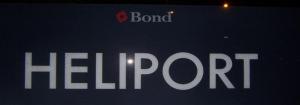
Ten of us met up ( eventually ) outside the office of Bond helicopters at the SECC in Glasgow. Initially the numbers were low, but then the Inverclyde squad turned up, quickly followed by another three who had met up in the car park next door. John then phoned his contact, and we were soon let in to the office by Air Observer PC Simon Shanks. Simon greeted us all and took us out onto the helipad area. We were told that the helicopters based at this site are all owned and operated by Bond Air Services who are one of the largest helicopter operators in the UK. Three aircraft are stationed at the Glasgow helipad and these are operated on behalf of Strathclyde Police, The Lighthouse Board and the Scottish Ambulance Service who also have another helo’ based at Inverness.
The air Ambulance of the Scottish Ambulance Service – call sign Helimed 5 – had just been scrambled to attend at the Island of Ghia, so we made our way into another window lined office and were just feet away from the SAS helo’ as it wound up ready for take off. You could feel the power of the twin engines of the Eurocopter EC.135T2+ and see the flaming exhausts as we were positioned behind it. The helo’ initially powered up and went into a hover just feet above the ground but to the side of the H landing pad. At this point, the pilot was contacting Air Traffic Control at Glasgow airport requesting permission to ‘launch’. Once he had the green light, the pilot maneuvered the aircraft back over the landing pad, and as the power went on, he lifted higher from the ground while at the same time going in reverse and disappeared out of view over the top of the hanger building we were in. Once everything looked good, he then flew off down the Clyde and onward to his destination. PC Shanks explained that the pilots took off in this fashion so that if anything were to go wrong then they could glide back down onto the helipad and not into the river! On the subject of the pilots, we were told that they were rostered a month with the Police helicopter, and a month with the Air Ambulance which gave them experience of the different roles. The pilots that fly Bonds helicopters are usually military trained with perhaps 15 or so years of flying experience with the forces and thus have a wealth of knowledge at their disposal.
Once Helimed 5 was safely on its way and was just a couple of twinkling lights in the distance on such a clear night, we went out to see the Police helicopter call sign Victor Mike 70. The first thing that strikes you is that the helicopter looks in as new condition even though it was a 2007 model. Obviously a lot of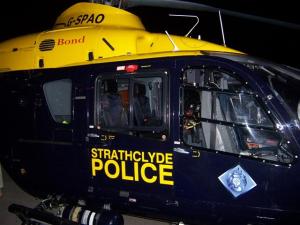 care goes into the maintenance regime, something I’m sure all the Police Officers who fly in her will be very grateful about. The interior of the aircraft is set out such that 4 seated people can be accommodated, although it usually flies with just three. This compliment is made up of the pilot, a front observer and a rear observer. The front seat observer is responsible for navigation, communication with Force control and the operational control of the aircraft. The rear seat observer communicates with Divisional control rooms, takes aerial photographs and operates various items of equipment. All crew are equipped with flying helmets, flame-retardent flying suits and life vests. All crew are also trained in underwater escape techniques. Between them, the two Police observers have something like 1.5 million pounds of equipment at their disposal with which to chase and capture bad guys. This very expensive and impressive arsenal includes :-
care goes into the maintenance regime, something I’m sure all the Police Officers who fly in her will be very grateful about. The interior of the aircraft is set out such that 4 seated people can be accommodated, although it usually flies with just three. This compliment is made up of the pilot, a front observer and a rear observer. The front seat observer is responsible for navigation, communication with Force control and the operational control of the aircraft. The rear seat observer communicates with Divisional control rooms, takes aerial photographs and operates various items of equipment. All crew are equipped with flying helmets, flame-retardent flying suits and life vests. All crew are also trained in underwater escape techniques. Between them, the two Police observers have something like 1.5 million pounds of equipment at their disposal with which to chase and capture bad guys. This very expensive and impressive arsenal includes :-
Nitesun – a hugely powerful spotlight ( 30 million candle power ) that can be focused from an area covering half a football pitch to a spot which can be used to direct ground forces to a particular area. There is also a filter that can be used to cover the output from the light so that it is invisible with the naked eye, but can be used with night vision equipment when the aircraft wants to be more stealthy, or indeed just so that the light is not being used by the criminal to light up his means of escape.
Forward Looking InfraRed ( FLIR ) This is as its name suggests, and is used to detect heat signatures from people, cars, and indeed anything that gives off heat. This is the thing you usually see when watching ‘Police Stop’ type programmes. An excellent and expensive piece of kit, it is an invaluable aid to modern Policing and has trapped many criminals. It can be used at night to detect a person hiding in undergrowth or maybe even in a wheely bin by the experienced operator. The eye in the sky will then direct ground forces to search a specific area. Not just criminals are tracked with this system, a lot of the work done by the Police helicopter involves finding missing persons, maybe children who have wandered off, or perhaps a senior citizen with Alzheimer’s who has taken a wrong turn and cannot make their way home.
Digital Film Cameras The cameras on todays modern Police helicopter are at the cutting edge of technology. Using digital recording techniques, the operator can view picture in picture images of suspects apprehended by ground based Officers. This way he can positively identify a suspect who can then be arrested. The cameras are gyroscopically stabilised and can read a car number plate from 800 feet in the air. The images from these cameras can be sent via microwave downlink to incident commanders on the ground who can command the helo’ during major incidents etc. The helo’ is also used to take pictures of scenes of crime from the air, and also pictures of things like road junctions when a fatal accident may have occurred. These images are then used in court as evidence or aids for jurors so they can see the layout of the junctions etc. Stills cameras are also carried in a regular camera bag and can act as a back-up, or to be used on scene when the helo’ is on the ground.
SkyShout A very loud public address system ( 700 watt ) which is so loud that the aircraft has a minimum height it has to attain before the system can be used. Police sirens can be played over the system, or the operator can talk directly into it via a microphone. It is used to direct ground forces during things like flooding, missing persons etc and also to talk directly to suspected criminals to instruct them to lay down weapons or the like untill ground crews can apprehend the them.
There were many more gadgets on the helicopter that PC Shanks explained to us, but to be honest,it would take up much more time than I have to write this blog.
A couple of examples of recent incidents were given to us to help explain what roles the helicopter can take on. The first was of a group of female walkers who had become lost on the Beinn Mhor hills above Benmore botanical gardens outside Dunoon. The helicopter was sent to find the distressed ladies, and once it had done so, proceeded to ferry them two by two from the top of the hill down to safety. Another example was of a car accident that was attended by the Air Support Unit. An injured child had to be taken to hospital ASAP. The road Ambulance was in attendance, but was going to take a time to get the casualty to the nearest hospital. With the Air Ambulance unavailable, it was decided to strip the spare seat and equipment out of the rear of the Police helicopter and to load the child into the helicopter on the trolley cot ( stretcher ) from the road ambulance. Once secured in place, the rear Police observer gave up his seat and one of the crew from the road Ambulance accompanied the injured child to hospital. This quick change from Police helicopter to rescue helicopter can easily be achieved due to the fact that both Ambulance and Police ‘copters are the same model. Indeed, the old Police helicopter that served Strathclyde has moved on to become a Helimed ( all UK Ambulance helicopters have this call sign with a different number following it ) in the North of England!
Once Simon had finished his very educational talk, it was Q+A time. Things like cruising speed ( 130 mph ) and response time ( 30 mins to Oban for example ) were asked about and we were told we could take some pics of the aircraft. My non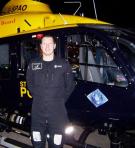 professional camera was pressed into service, and I must apologise for the poor standard of the pics. Trying to take a photo of a dark blue helicopter at night is not something my wee camera copes with very well. Incidentally, the colour scheme is used on all UK Police helicopters. This yellow over blue ‘wasp’ paint job is regarded as the most effective in reducing the risk of mid-air collisions with low flying military aircraft and also is very visible from the ground to reassure the law-abiding citizen, and serve as a warning to criminals.
professional camera was pressed into service, and I must apologise for the poor standard of the pics. Trying to take a photo of a dark blue helicopter at night is not something my wee camera copes with very well. Incidentally, the colour scheme is used on all UK Police helicopters. This yellow over blue ‘wasp’ paint job is regarded as the most effective in reducing the risk of mid-air collisions with low flying military aircraft and also is very visible from the ground to reassure the law-abiding citizen, and serve as a warning to criminals.
The night wasn’t getting any warmer so it was brought to a close with a quick chat in the duty room where the airwave radios were alive with chatter. Everyone thanked PC Shanks for his very enlightening talk and we all agreed that it was an excellent outing for the club.
UPDATE 30 NOV 13 – Last night 29/11/13, the Police helicopter crashed into the roof of the Clutha Vaults pub in Glasgow. At this time it is know three people have died, our thoughts are with their families and our hopes are with the tens of injured and we wish them a speedy recovery.
UPDATE 02 DEC 13 – It has now been confirmed by Police Scotland that nine people perished inside the Clutha Vaults. These included the three crew of the helicopter and six patrons of the pub.

